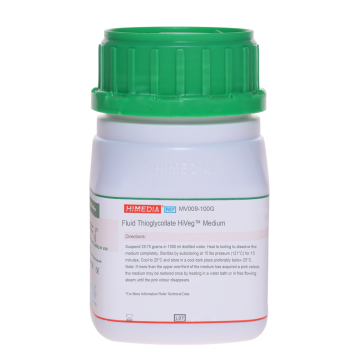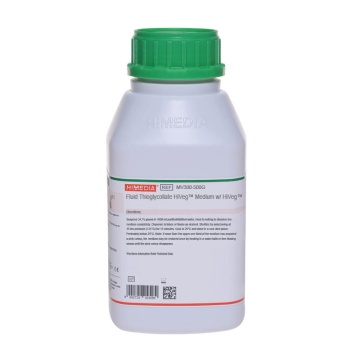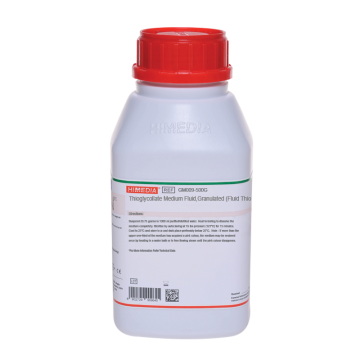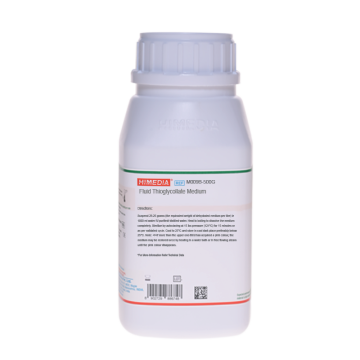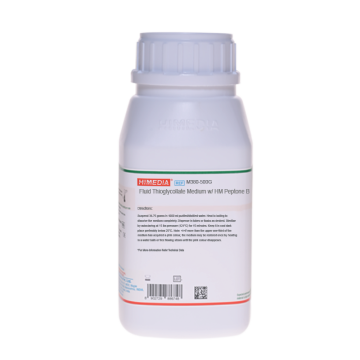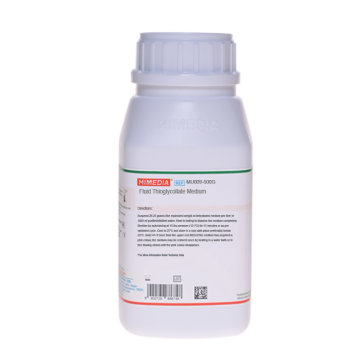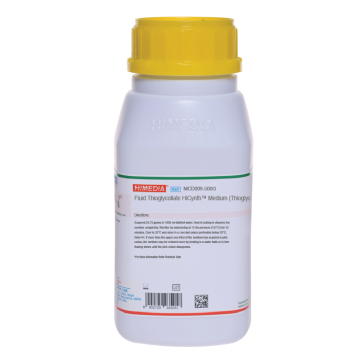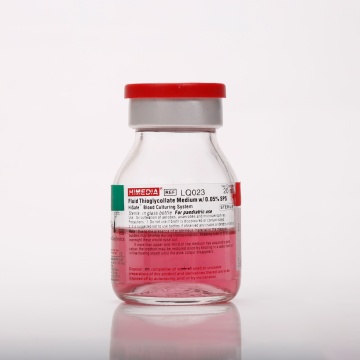 Your enquiry has been submitted
Your enquiry has been submitted
Fluid Thioglycollate Medium (Thioglycollate Medium, Fluid)
Intended Use
Recommended for sterility testing of biologicals and for cultivation of anaerobes, aerobes and microaerophiles from pharmaceutical and clinical samples.
Composition
| Ingredients | g/L |
|---|---|
| Tryptone | 15.000 |
| Yeast extract | 5.000 |
| Dextrose (Glucose) | 5.500 |
| Sodium chloride | 2.500 |
| L-Cystine | 0.500 |
| Sodium thioglycollate | 0.500 |
| Resazurin sodium | 0.001 |
| Agar | 0.750 |
Final pH (at 25°C): 7.1±0.2
**Formula adjusted, standardized to suit performance parameters
Directions
Suspend 29.75 grams in 1000 ml purified/distilled water. Heat to boiling to dissolve the medium completely. Sterilize by autoclaving at 15 lbs pressure (121°C) for 15 minutes. Cool to 25°C and store in a cool dark place preferably below 25°C.
Note: If more than the upper one-third of the medium has acquired a pink-purple colour, the medium may be restored once by heating in a water bath or in free flowing steam until the pink-purple colour disappears.
Principle And Interpretation
Brewer (1) formulated Fluid Thioglycollate Medium for rapid cultivation of aerobes as well as anaerobes including microaerophiles by adding a reducing agent and small amount of agar. The BP (2), EP (3), USP (4), and AOAC (5) have recommended the media for sterility testing of antibiotics, biologicals and foods and for determining the phenol coefficient and sporicidal effect of disinfectants. However, it is intended for the examination of clear liquid or water-soluble materials. Fluid Thioglycollate Medium is also routinely used to check the sterility of stored blood in blood banks (6).
Dextrose, tryptone, yeast extract, L-cystine provide the growth factors necessary for bacterial multiplication. L-cystine and sodium thioglycollate allows Clostridium to grow in this medium even under aerobic conditions (7). Also the small amount of agar used in the medium favors the growth of aerobes as well as anaerobes in the medium, even if sodium thioglycollate is deleted from the medium(1). Sodium thioglycollate act as a reducing agent and neutralizes the toxic effects of mercurial preservatives and peroxides formed in the medium, thereby promoting anaerobiosis, and making the medium suitable to test materials containing heavy metals. (8,9). Any increase in the oxygen content is indicated by a colour change of redox indicator, resazurin to red (6,10,11). The small amount of agar helps in maintaining low redox potential for stabilizing the medium (9).
Type of specimen
Pharmaceutical samples for sterility testing, clinical samples- pus, wounds
Specimen Collection and Handling:
For clinical samples follow appropriate techniques for handling specimens as per established guidelines (12,13).
For pharmaceutical samples, follow appropriate techniques for sample collection, processing as per guidelines (2,3,4) After use, contaminated materials must be sterilized by autoclaving before discarding.
Warning and Precautions
In Vitro diagnostic Use. For professional use only. Read the label before opening the container. Wear protective gloves/protective clothing/eye protection/ face protection. Follow good microbiological lab practices while handling specimens and culture. Standard precautions as per established guidelines should be followed while handling clinical specimens. Safety guidelines may be referred in individual safety data sheets.
Limitations
- 1. It is intended for the examination of clear liquid or water-soluble materials.
Performance and Evaluation
Performance of the medium is expected when used as per the direction on the label within the expiry period when stored at recommended temperature.
Quality Control
Appearance: Cream to yellow homogeneous free flowing powder
Colour and Clarity of prepared medium: Light straw coloured, clear to slightly opalescent solution with upper 10% or less medium pink-purple on standing.
Reaction: Reaction of 2.97% w/v aqueous solution at 25°C. pH: 7.1±0.2
pH: 6.90-7.30
Growth Promotion Test: As per USP/EP/BP/IP
Growth promoting properties: Clearly visible growth of microorganism comparable to that previously obtained with previously tested and approved lot of medium occurs at the specified temperature for not more than the shortest period of time specified inoculating <=100 cfu at 30-35°C for or not more than 3 days for aerobes and anaerobes.
Sterility Testing + Validation: The medium is tested with suitable strains of microrganisms inoculating <=100cfu and incubating at 20-25°C for not more than 3 days in case of bacteria and not more than 5 days in case of fungi.
Testing in accordance with EN ISO 11133:2014/Amd.1:2018(E) (10): Cultural characteristics observed after an incubation at 36-38°C for 18-24 hours
Growth promoting (30-35°C)
| Organism | Inoculum (CFU) | Growth | Incubation at |
|---|---|---|---|
| Staphylococcus aureus subsp. aureus ATCC 6538 (00032*) | 50-100 | luxuriant | 30-35°C |
| Staphylococcus aureus subsp. aureus ATCC 25923 (00034*) ^ | 50-100 | luxuriant | 30-35°C |
| $ Bacillus spizizenii ATCC 6633 (00003*) | 50-100 | luxuriant | 30-35°C |
| ^Pseudomonas paraeruginosa ATCC 9027 (00026*) | 50-100 | luxuriant | 30-35°C |
| ##Kocuria rhizophila ATCC 9341 | 50-100 | luxuriant | 30-35°C |
| Clostridium sporogenes ATCC 19404 (00008*) | 50-100 | luxuriant | 30-35°C |
| Clostridium sporogenes ATCC 11437 | 50-100 | luxuriant | 30-35°C |
| $Phocaeicola vulgatus ATCC 8482 | 50-100 | luxuriant | 30-35°C |
| Escherichia coli ATCC 8739 (00012*) | 50-100 | luxuriant | 30-35°C |
| Salmonella Typhimurium ATCC 14028 (00031*) | 50-100 | luxuriant | 30-35°C |
| Salmonella Abony NCTC 6017 | 50-100 | luxuriant | 30-35°C |
Sterility Testing- Growth promotion + Validation (20-25°C)
| Organism | Inoculum (CFU) | Growth | Incubation at |
|---|---|---|---|
| Staphylococcus aureus subsp. aureus ATCC 6538 (00032*) | 50-100 | luxuriant | 20-25°C |
| $ Bacillus spizizenii ATCC 6633 (00003*) | 50-100 | luxuriant | 20-25°C |
| ^Pseudomonas paraeruginosa ATCC 9027 (00026*) | 50-100 | luxuriant | 20-25°C |
| ##Kocuria rhizophila ATCC 9341 | 50-100 | luxuriant | 20-25°C |
| Candida albicans ATCC 10231 (00054*) | 50-100 | luxuriant | 20-25°C |
| #Aspergillus brasiliensis ATCC 16404 (00053*) | 50-100 | luxuriant | 20-25°C |
Cultural characteristics observed (36-38°C)
Cultural characteristics observed after an incubation at 36-38°C for 18-24 hours
| Organism | Inoculum (CFU) | Growth | Incubation at |
|---|---|---|---|
| Clostridium perfringens ATCC 13124 (00007*) | 50-100 | luxuriant | 36-38°C |
Key:
- * Corresponding WDCM numbers,
- ## Formerly known as Micrococcus luteus
- $ Formerly known as Bacteroides vulgatus
- # Formerly known as Aspergillus niger,
- $ Formerly known as Bacillus subtilis subsp. spizizenii
- ^ Formerly known as Pseudomonas aeruginosa
Disposal
User must ensure safe disposal by autoclaving and/or incineration of used or unusable preparations of this product. Follow established laboratory procedures in disposing of infectious materials and material that comes into contact with clinical sample must be decontaminated and disposed of in accordance with current laboratory techniques (12,13).
Reference
- Brewer, 1940, J. Am. Med. Assoc., 115:598.
- The British Pharmacopoeia, 2022, Medicines and Healthcare products Regulatory Agency.
- European Pharmacopoeia, 2022, 10 th volume, European Directorate for the quality of medicines & Healthcare.
- The United States Pharmacopoeia-National Formulatory (USP-NF), 2022
- Williams H., (Ed.), 2005, Official Methods of Analysis of the Association of Official Analytical Chemists, 19th Ed., AOAC,Washington, D.C
- Nungester, Hood and Warren, 1943, Proc. Soc. Exp. Biol. Med., 52:287.
- Portwood, 1944, J. Bact., 48:255.
- Federal Register, 1992, Fed. Regist., 21:640.
- Quastel and Stephenson, 1926, J.Biochem., 20
- Marshall, Gunnison and Luxen, 1940, Proc. Soc. Exp. Biol. Med., 43:672.
- MacFaddin J.F., 1985, Media for Isolation-Cultivation-Identification-Maintenance of Medical Bacteria, Vol. 1, Williams and Wilkins, Baltimore.
- Isenberg, H.D. Clinical Microbiology Procedures Handbook 2nd Edition.
- Jorgensen, J.H., Pfaller, M.A., Carroll, K.C., Funke, G., Landry, M.L., Richter, S.S and Warnock., D.W. (2015) Manual of Clinical Microbiology, 11th Edition. Vol. 1.
| Product Name | Fluid Thioglycollate Medium (Thioglycollate Medium, Fluid) |
|---|---|
| SKU | M009 |
| Product Type | Regular |
| Physical Form | Powder |
| Origin | Animal |
| Packaging type | HDPE |
| References | 1.Brewer, 1940, J. Am. Med. Assoc., 115:598. 2.The United States Pharmacopoeia, 2018, The United States Pharmacopoeial Convention, Rockville, MD. 3.British Pharmacopoeia, 2016, The Stationery office British Pharmacopoeia4.European Pharmacopoeia, 2017, European Dept. for the quality of Medicines. 5.Williams H., (Ed.), 2005, Official Methods of Analysis of the Association of Official Analytical Chemists, 19th Ed., AOAC,Washington, D.C 6.Marshall, Gunnison and Luxen, 1940, Proc. Soc. Exp. Biol. Med., 43:672. 7.Nungester, Hood and Warren, 1943, Proc. Soc. Exp. Biol. Med., 52:287. 8.Portwood, 1944, J. Bact., 48:255. 9.MacFaddin J.F., 1985, Media for Isolation-Cultivation-Identification-Maintenance of Medical Bacteria, Vol. 1, Williamsand Wilkins, Baltimore. 10.Federal Register, 1992, Fed. Regist., 21:640.0.. 11. Quastel and Stephenson, 1926, J.Biochem., 20:1.. 12.Isenberg, H.D. Clinical Microbiology Procedures Handb0ook. 2nd Edition.13Jorgensen,J.H., Pfaller , M.A., Carroll, K.C., Funke, G., Landry, M.L., Richter, S.S and Warnock., D.W. (2015)Manual of Clinical Microbiology, 11th Edition. Vol. 1. |
| Customized Product Available | No |




